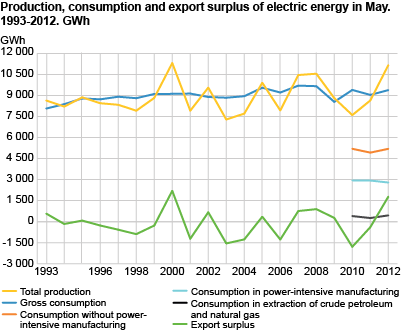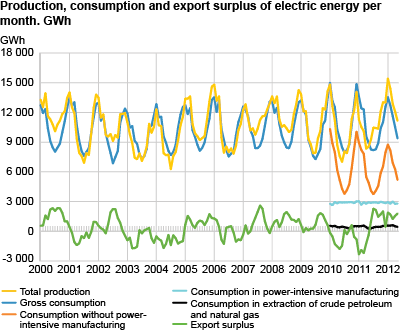Content
Published:
This is an archived release.
Very high electricity generation and net exports
Electricity production came to 11 161 GWh in May 2012. This is 29 per cent higher than in May last year and the second highest level ever recorded for the month since the monthly electricity statistics started in 1979. The net exports also reached a high level.
The high electricity generation may be seen in conjunction with the large volume of water in the Norwegian reservoirs and expectations of a large inflow of water from melting snow in the mountains. According to the Norwegian Water Resources and Energy Directorate, the reservoir filling was 42.0 per cent at the beginning of May. Throughout the month, the filling rose by 4.7 percentage points to 46.7 per cent at the end of week 21. The median filling for the corresponding week in the years 1990-2011 is 43.1 per cent.
From net import to net export of power
Norway’s export of power totalled 2 004 GWh in May 2012, whereas imports came to 224 GWh. This gave a net export of 1 780 GWh and is the second highest level ever recorded for May. In the same month last year the situation was different; Norway had a net import of 396 GWh. Exchange of power between countries is determined by differences in generation and the consumption situation and prices, in addition to the capacity of the power lines. The high net export may be due to the fact that the large volume of water in the Norwegian power system contributed to a lower average elspot price in May for the Norwegian price areas compared with the other Nordic areas.
Rise in the total electricity consumption
The total gross consumption of electricity came to 9 382 GWh in May; an increase of 3.8 per cent compared with the same month in 2011. The gross consumption of electricity encompasses consumption in the groups extraction of crude oil and natural gas, power-intensive manufacturing and
electricity consumption excluding power-intensive manufacturing and extraction. Net loss, pump storage use and other own consumption in the power stations are also included.
Increase in the electricity consumption excluding power-intensive manufacturing and extraction
Electricity consumption excluding power-intensive manufacturing and extraction amounted to 5 193 GWh in May; an increase of 5.5 per cent compared with the same month in 2011. Among other things, this may be seen in conjunction with a 0.7 degrees lower average temperature for Norway as a whole in May this year. Households, services and manufacturing other than the power-intensive manufacturing account for the majority of the electricity consumption excluding power-intensive manufacturing and extraction. Electricity consumption in households amounts to approximately 50 per cent of the electricity consumption excluding power-intensive manufacturing and extraction.
Decrease in the consumption in power-intensive manufacturing
Electricity consumption in power-intensive manufacturing was 2 788 GWh in May 2012. This is 4.9 per cent lower compared with May 2011. The decline may be seen in conjunction with closures of some wood processing establishments and reduced activity in some of the plants in the industry chemical commodity due to maintenance. Power-intensive manufacturing utilises electricity for the production of goods. Hence, the electricity consumption is not influenced by temperature.
Tables:
Contact
-
Magne Holstad
E-mail: magne.holstad@ssb.no
tel.: (+47) 40 90 23 42
-
Ingvild Røstøen Ruen
E-mail: ingvild.ruen@ssb.no
tel.: (+47) 40 81 13 97
-
Tom Jonas Billit
E-mail: tom.billit@ssb.no
tel.: (+47) 40 81 13 45
-
Thomas Aanensen
E-mail: thomas.aanensen@ssb.no
tel.: (+47) 40 90 23 48


